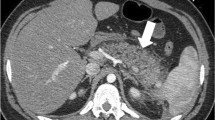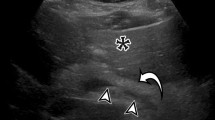Opinion statement
The management of pancreatic trauma provides trauma surgeons with diagnostic and therapeutic challenges. The two most important facts that must be established are the location of the injury in relation to the superior mesenteric artery and vein and the status of the main pancreatic duct. If a pancreatic injury is discovered at the time of exploration and no main ductal injury is found, debridement and wide drainage are adequate therapy regardless of the location of the injury. If the status of the duct cannot be confidently determined and the injury lies to the left of the vessels, a single attempt at cholecystocholangiography should be performed. If this is unsuccessful, distal pancreatectomy with splenectomy with no further attempts at ductal imaging are our treatments of choice. Splenic salvage may be considered in the pediatric population. If the injury lies to the right of the vessels and the status of the duct is not able to be diagnosed with thorough exploration, we recommend endoscopic retrograde cholangiopancreatography (ERCP), either intraoperatively or on an urgent basis postoperatively, with wide closed suction drainage prior to closure of the abdomen. If the ERCP shows intact pancreatic and common bile ducts, expectant management is warranted. If the duct is injured, the patient is returned to the operating room for debridement of the injury, oversewing of the proximal pancreatic duct, and a distal pancreaticojejunostomy. Use of ERCP to stent this injury type has been reported but has yet to be rigorously studied. If the ampulla is destroyed or the pancreatic head is devascularized, pancreaticoduodenectomy is required either at the original surgery or after patient stabilization if damage control laparotomy is necessary. If a stable trauma patient has findings on a computed tomography suggestive of an isolated pancreatic injury, we still recommend laparotomy using the previously mentioned algorithm. All patients with pancreatic injury should have feeding access placed intraoperatively beyond the ligament of Treitz, with our choice being a nasal-jejunal feeding tube. Postoperative pancreatic fistulae should be managed with adequate closed suction drainage, octreotide, and observation for a period of at least 4 to 8 weeks prior to contemplation of surgical intervention.
Similar content being viewed by others
References and Recommended Reading
Moore EE, Cogbill TH, Malangoni MA, et a1.: Organ Injury Scaling II: Pancreas, duodenum, small bowel, colon, and rectum. J Trauma 1990, 30: 1427–1429.
Bradley EL, Young PR, Chang MC, et al.: Diagnosis and initial management of blunt pancreatic trauma: guidelines from a multiinstitutional review. Ann Surg 1998, 227: 861–869.
Asensio JA, Demetriades D, Hanpeter DE, et al.: Management of pancreatic injuries. Curr Probl Surg 1999, 36: 326–419.
Takishima T, Sugimoto K, Hirata M, et al.: Serum amylase level on admission in the diagnosis of blunt injury to the pancreas. Its significance and limitations. Ann Surg 1997, 226: 70–76.
Patton JH, Lyden SP, Croce MA, et al.: Pancreatic trauma: a simplified management guideline. J Trauma 1997, 43: 234–241.
Patel SV, Spencer JA, El-Hasani S, et al.: Imaging of pancreatic trauma. Br J Radiol 1998, 71: 985–990.
Clements RH, Reisser JR: Urgent endoscopic retrograde pancreatography in the stable trauma patient. Amer Surg 1996, 62: 446–448.
Wind P, Tiret E, Cunningham C, et al.: Contribution of endoscopic retrograde pancreatography in management of complications following distal pancreatic trauma. Amer Surg 1999, 65: 777–783.
Whitwell AE, Gomez GA, Byers P, et al.: Blunt pancreatic trauma: prospective evaluation of early endoscopic retrograde pancreatography. South Med Journal 1989, 825: 586.
Doctor N, Dooley JS, Davidson BR: Assessment of pancreatic duct damage following trauma: is endoscopic retrograde cholangiopancreatography the gold standard? Postgrad Med J 1995, 71: 116–117.
Wright MJ, Stanski C: Blunt pancreatic trauma: a difficult injury. South Med Journal 2000, 93: 383–385.
Takishima T, Horiike S, Sugimoto K, et al.: Role of repeat computed tomography after emergency endoscopic retrograde pancreatography in the diagnosis of traumatic injury to pancreatic ducts. J Trauma 1996, 40: 253–257.
Asensio JA, Demetriades D, Berne JD: A unified approach to the surgical exposure of pancreatic and duodenal injuries. Amer J Surg 1997, 174: 54–60.
Pachter HL, Hofstetter SR, Liang HG, et al.: Traumatic injuries to the pancreas: the role of distal pancreatectomy with splenic preservation. J Trauma 1989, 29: 1352.
Jones RC, Shires T: Pancreatic trauma. Arch Surgery 1971, 102: 424–430.
De Kerpel W, Hendrickx T, Vanrykel JP: Whipple procedure after blunt abdominal trauma. J Trauma 2002, 53: 780–783.
Delcore R, Stauffer JS, Thomas VH, et al.: The role of pancreaticogastrostomy following pancreaticoduodenectomy for trauma. J Trauma 1994, 37: 395–399.
Traverso LW, Longmire WP: Preservation of the pylorus in pancreaticoduodenectomy. Surg Gynecol Obstet 1970, 46: 959–962.
Koniaris LG, Mandal AK, Genuit T, et al.: Two-stage pancreaticoduodenectomy: delay facilitates anastomotic reconstruction. J Gastrointestinal Surg 2000, 4: 366–369.
Asensio JA, Patrizio P, Roldan G, et al.: Pancreaticoduodenectomy: A rare procedure for the management of complex pancreaticoduodenal injuries. JACS 2003, 197: 937–942. A thorough review of the procedure as well as its modifications.
Gentilello LM, Cortes V, Buechter KJ, et al.: Whipple procedure for trauma: is duct ligation a safe alternative to pancreaticojejunostomy? J Trauma 1991, 31: 661–668.
Pederzoli P, Bassi C, Falconi M, et al.: Conservative treatment of external pancreatic fistulas with parenteral nutrition alone or in combination with continuous intravenous infusion of somatostatin, glucagon, or calcitonin. Surg Gynecol Obstet 1986, 163: 428–432.
Stojadinovic A, Brooks A, Hoos A, et al.: An evidencebased approach to the surgical management of resectable pancreatic adenocarcinoma. JACS 2003, 196: 954–964.
Amirata E, Livingston DH, Elcavage J: Octreotide acetate decreases pancreatic complications after pancreatic trauma. Amer J Surg 1994, 168: 345–347.
Li-Ling J, Irving M: Somatostatin and octreotide in the prevention of postoperative pancreatic complications and the treatment of enterocutaneous pancreatic fistulas: a systematic review of randomized controlled trials. Br J Surg 2001, 88: 190–199.
Ridgeway MG, Stabile BE: Surgical management and treatment of pancreatic fistulas. Surg Clinics of North America 1996, 76: 1159–1173.
Nirula R, Velmahos GC, Demetriades D: Magnetic resonance cholangiopancreatography in pancreatic trauma: a new diagnostic modality. J Trauma 1999, 47: 585–587.
Sugiyama M, Atomi Y, Kuroda A, et al.: Endoscopic ultrasonography for diagnosing blunt pancreatic trauma. Gastrointestinal Endoscopy 1996, 44: 723–725.
Hsieh CH, Liu NJ, Chen RJ, et al.: Endoscopically placed pancreatic stent in a patient with concomitant two locations of main pancreatic duct disruption following pancreatic trauma. Hepatogastroenterology 2003, 50: 269–271.
Huckfeldt R, Agee C, Nichols WK, et al.: Nonoperative treatment of traumatic pancreatic duct disruption using an endoscopically placed stent. J Trauma 1996, 41: 143–144.
Kim HS, Lee DK, Kim W, et al.: The role of endoscopic retrograde pancreatography in the treatment of traumatic pancreatic duct injury. Gastrointestinal Endoscopy 2001, 54: 49–55.
Author information
Authors and Affiliations
Rights and permissions
About this article
Cite this article
Phelan, H.A., Minei, J.P. Pancreatic trauma: Diagnostic and therapeutic strategies. Curr Treat Options Gastro 8, 355–363 (2005). https://doi.org/10.1007/s11938-005-0038-4
Issue Date:
DOI: https://doi.org/10.1007/s11938-005-0038-4




